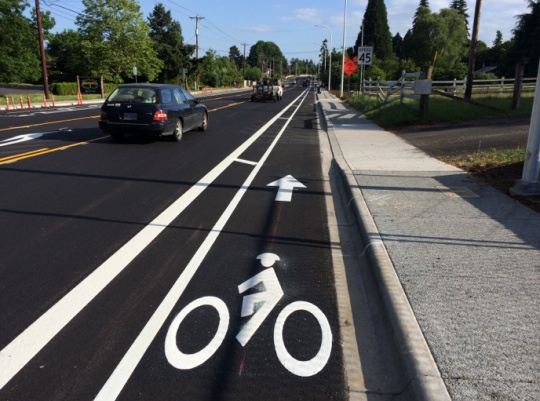
(Photo: Robin Straughan)
Reader Robin Straughan sent in the news that Washington County has added buffered bike lanes and a sidewalk to a one-mile stretch of SW Boones Ferry Road between Tualatin and Wilsonville (map).
The $10 million project (paid for through a combo of local and state funds) widened and repaved the roadway in addition to improving bicycling and walking access.
Here’s more from Robin:
“This is a major bike commute route as well as north-south thoroughfare for anyone riding in the area. It used to be extremely treacherous due to a non-existent bike lane, no shoulder, fast cars, and terrible pavement. This project has made the road much better for all users. As a 45 MPH semi-rural road between the two cities, it feels much safer with the improvements. This year-long project added a real bike lane to a stretch of Boones Ferry Rd that had no bike infrastructure and connects it to other segments that already had bike lanes or ride-able shoulders.
Advertisement
Here’s a before photo to give you a sense of what it used to be like:
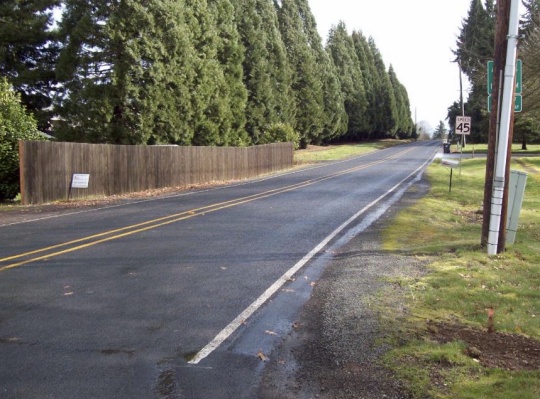
And another angle from Robin:
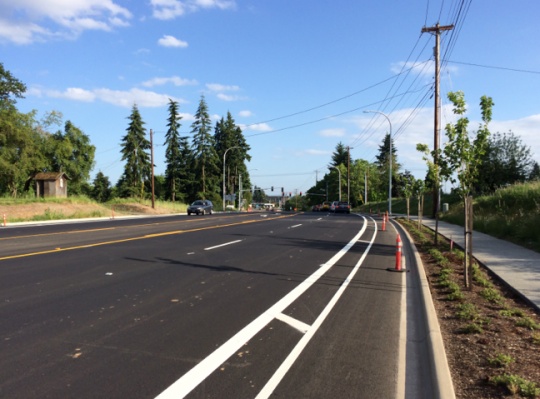
Buffered bike lanes are relatively rare in Washington County. The first ones were installed back in September 2011.
Check out the official project page for more info.



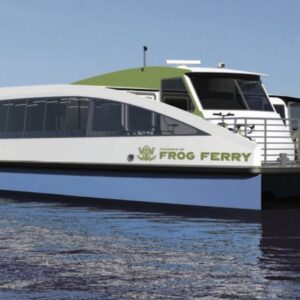
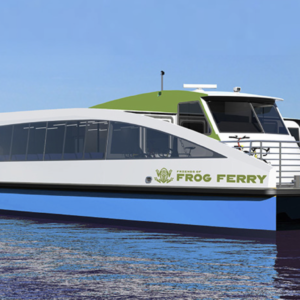
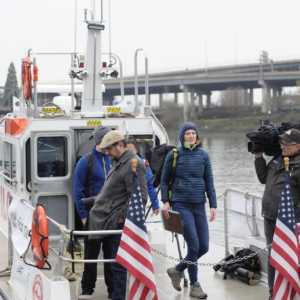
Thanks for reading.
BikePortland has served this community with independent community journalism since 2005. We rely on subscriptions from readers like you to survive. Your financial support is vital in keeping this valuable resource alive and well.
Please subscribe today to strengthen and expand our work.
Even though I love seeing this, I’m still not sure why we can’t get real cycle tracks on roads like this if we’re adding sidewalks and all that jazz. Just painting on stripes really does only so much to encourage cycling. As has been pointed out, even Amsterdam saw a huge percentage difference with bike lane style paint vs. actually have cycle tracks.
This is great, but by no means a way to achieve Amsterdam or Copenhagen level greatness. So kudos for this much progress, but I’m really looking forward to some legitimate REAL progress in making this biking revolution permanent.
…cycle track permanence will see it’s own percentage increases.
Seriously. Take a look at project plans and you’ll still see conventional bike lanes drawn onto newly rebuilt roads.
The good news is that these lanes are wide enough that they can be retrofitted in the future as protected bike lanes. It’s the standard 5-6 ft lanes on new construction that are really bothersome, as they are too narrow to simply turn into functional protected lanes.
Nick – show me some DOT client standards that require buffered bike lanes and I’ll show you project plans that include them.
given funding constraints and a truly massive connectivity deficit i prefer miles of buffered bike lane to another block or two of cycle track built on the “cheap”.
Yes, with 45 mph traffic whizing by, a foot or two of painted stripes isn’t going get many new people biking here.
given funding constraints and a truly massive connectivity deficit i prefer miles of buffered bike lane to another block or two of cycle track built on the “cheap”.
a bike lane buffered by a stripe is just a normal bike lane… all bike lanes are buffered by a white stripe…
this does nothing to keep motor vehicles out of the bike lane… but it further enforces that bikes should be in the gutter…
but at least it has a bike lane, sidewalks, and center turn lane now…
Huh? Having a wider lane means that “bikes should be in the gutter”? I’m lost on this one.
This is WORSE than the status-quo because it gives those in charge the right to say: “look, we did something.” No amount of white paint is going to change the laws of physics. We need actual separated bike lanes. What is so disappointing about this is that in the “before” picture, there is clearly room to build a buffered bike lane.
This IS a buffered bike lane. You must mean separated bike lane. And if you think this is worse than status quo, ie the old situation with no shoulders and only a pitiful fog line, then you need to look up the expression involving horses, gifts and mouths.
I don’t understand what physics have to do with it. Bike lane buffers (hashed lines) have actually been shown to reduce traffic speeds because they have the visual effect of communicating danger (again, I don’t have the study reference but I’ve read it). Car-bike collisions are statistically much lower than individual cycling crashes, and predominately at intersections and not mid-block. At those intersections the crossings for separated cycle tracks become significantly more unsafe than bike lanes adjacent to auto traffic (or preferably integrated with dedicated turn lanes where roads are wide enough).
I know staff involved with this project who ride this very road. I guarantee you they have more at stake beyond bragging rights in building the safest infrastructure they can afford.
Right. But part of the issue is that for the large numbers of people who would bike but for their own *perceived* safety, riding next to traffic that goes 45 mph (and probably more) is not inviting. This might in all actual fact be safer for everyone, and feel safer to ride for someone who’s used to riding in a narrow bike lane with less white stripe buffer, but it’s not going to be a viable route for those newer or would-be cyclists who see the 45 mph sign and *feel* like, wow, that’s crazy to ride by drivers going that fast.
Infrastructure can’t just *be* safer, statistically speaking, than what we have now, it has to be more inviting in the psychological sense than what we have now. That’s why it’s hard to get too excited about these kinds of “upgrades.”
Four times I’ve posted a comment that’s been moderated out, the last in reply to Opus the Poet on this very subject. I don’t disagree with the need for separated bike infrastructure, it just doesn’t make sense in this section that links together two areas of unbuffered bike lanes. This is a commuter route, and cyclists on this route (like I used to be) were already riding it with no bike lane at all. If we want to build infrastructure to get the “interested but concerned” crowd on their bikes there is PLENTY of opportunity in that region to do so – and I can assure you it’s being looked into.
I will (again) disagree with you and ‘m’ that this won’t increase ridership. Studies have shown that similar treatments have done so, but every time I post a link to the infographic the comment gets kicked. We don’t need to turn into Amsterdam to begin moving mode share from 6% into 7%. What we do need to do is train and mentor new riders to become confident riding in lanes like this (and traffic lanes with autos), as they will inevitably encounter that situation if they continue to ride anyway.
Most importantly, ALL of these approaches need to be utilized, I just disagree that a buffered bike lane here is a lost opportunity for a separated bike lane (which, as others have pointed out, many ‘utility’ cyclists do NOT prefer).
Cycling mode share in Osaka, Japan: 25%.
Miles of world-class protected/separated dutch/copenhagen-style cycle-tracks/paths: ZERO.
Not quite. In Osaka people mostly ride on the sidewalks and the sidewalks are often separated for pedestrians and bicycles- though the cyclists rarely stick to their side. There are separated cycle tracks, if not in Osaka proper at least in the suburbs.
fantastic! looks great!
“This IS a buffered bike lane. You must mean separated bike lane.”
You are correct, I meant separated bike lane not buffered lane. And by “worse” I am focusing on on a goal of getting more people out of their cars and onto their bikes. In my opinion, stuff like this does close to nothing for that cause with regard to the “interested but concerned” crowd. With regard to physics, I meant the simple point that close interaction between cars and bike should be avoided as much as possible. Cars obviously weigh a lot more than bikes Without physical barriers, bikes will lose every time. No amount of paint is going to change that.
the “physics” cycling is dangerous comment comes across as anti-cycling. moreover, this same argument is used by anti-bike cranks on o-live to tar cyclists as crazy/risk-taking/scofflaws. imo, if you are trying to promote cycling for transportation then this is exactly the wrong tactic.
In my opinion, stuff like this does close to nothing for that cause with regard to the “interested but concerned” crowd.
a survey conducted by jennifer dill of OTREC (a “bike belong” segregation supporter) found that the majority of portland residents rated a crappy conventional door zone bike lane as “comfortable” or better. i wonder how they would have rated a door zone-free buffered bike lane? probably a touch higher…
Speaking as an “interested but concerned” daily bike rider, the presence of bike lanes in some of the busier streets on my way to work–with just a stripe and a bike symbol every few yards–was a key to my decision to start bike commuting, and keep riding. Would I prefer better separation? Yes? Do I love riding a bike lane on a high-speed arterial? No I don’t. I often go out of my way to find safer-feeling routes, especially on unfamiliar trips.
But please don’t underestimate the power of plain old paint in the street and some signage in lowering the barrier for the “interested but concerned”.
It’s really interesting the difference some paint makes. No, it won’t stop a car from hitting you. But all this week I’ve been riding from Sellwood to Cleveland High with my [competent] 10 year old (up 17th, over new bridge, under bridge, then to Tibbetts) and it’s amazing how much both of us relax and enjoy the ride more when there are [painted] bike lanes. Because everyone is more predictable — bikes in one spot, cars in another, and we all get where we want to go.
I’m fine riding on a 45 (or even 55 mph) road with ‘only’ a bike lane. But I’ve found it fascinating to observe how much it matters even in low speed neighborhoods.
I live out here and I think this is great. It feels so much safer then before when there was nothing and you prayed every time a car passed that they wouldn’t hit you. Thank you Washington county.
a speed limit reduction would have helped too. 45 mph is far too fast…
No kidding. But recall that this change was accompanied by widening and straightening Boones Ferry at this location. Both of these changes have historically corresponded to *increased* speeds (see Barbur).
I feel pretty mixed about this. The bike lane is great with me (what it communicates to would-be or actual people biking & what it provides in terms of dedicated width of street for bikes), but the straightening and widening, with the attendant lopping off of people’s front yards not to mention the obliteration of large swaths of trees that were ‘in the way’ was hard to witness as I sat on the Trimet 96 bus which takes this route to & from Wilsonville.
it’s remarkable that “people who bike” focused their critique on the bike lane and not on the car-centric road design.
I agree about this. I saw the early plans for this when I worked in Wilsonville back in 2011 and biked that road, and the improvement is massive, but I was really disappointed that they widened the road as well, which will potentially increase car traffic, rather than just build a nice two-lane (+center turn lane) road with great bike lanes.
This is better than the non-buffered bike lanes, yes.
That said, we’d be able to get separated cycle tracks (and “separated sidewalks”, e.g. something other than the curb-tight sidewalk shown in one of the photos above) in all the places if the County weren’t constantly needing massive amounts of ROW for conversions from two lane roads to five+ lane roads. (Look at the increased number of planned expansions in the TSP draft and ask how much that costs. Also… how many places to turn are there in that last photo? WashCo uses ROW for center turn lanes even when it makes little sense.)
center turn lane does more that provide turn opportunities. the separation of opposing traffic reduces the likelihood of head-on collisions. Adding rumble strips inside the center turn lane marking could enhance that safety.
Washington County does a good thing and all these people respond with hate! Yes, a fully separated bikeway would be awesome. But where is the money? Is there even enough ROW to do it? Did any of the haters talk to WashCo about opportunities and constraints when they were budgeting and designing it? Probably not. What is the opportunity cost of a nice bikeway on this road? A whole bunch of other projects evaporate.
> Washington County does a good thing and all these people respond with hate!
I think you are assuming people are responding emotionally. I see a lot of thoughtful criticism (and a fair amount of general support) that I wouldn’t classify as hate, nor would I classify any of the above commenters as “haters”. But, to get to the rest of your remarks…
> But where is the money?
See: MSTIP, the Major Streets Transportation Improvement [sic] Program. The County has raised and spent over 1/2 billion dollars on over 100 projects. http://www.co.washington.or.us/LUT/TransportationFunding/what-is-mstip.cfm
> Is there even enough ROW to do it?
There is rarely ROW for the transportation facilities WashCo builds. Where they don’t have ROW, they buy it.
> Did any of the haters [sic] talk to WashCo about opportunities and constraints when they were budgeting and designing it? Probably not.
Can’t speak for the readers, but I served for about two years on the 2035 WashCo Transportation System Plan Citizen Advisory Committee. I probably have hundreds of emails back and forth with staff about issues like this.
> What is the opportunity cost of a nice bikeway on this road? A whole bunch of other projects evaporate.
Depending on the project, that’s a good thing. MSTIP funds plenty of projects that are not immediately necessary (e.g. widening a road from 2 lanes to 5+ lanes now because they say “the model” calls it necessary ten+ years from now, or putting turn lanes on bridges where no one can turn). They could trim down the projects (which is happening in the Bethany area where citizens are well enough organized to demand projects that better fit into their community), or cancel them completely (as should happen in examples like this: http://bikeportland.org/2013/11/15/priority-check-washington-county-will-spend-21-million-highway-improvement-project-97184).
Cheers!
~ P
This is WORSE than the status-quo
No amount of white paint is going to change the laws of physics.
Spending millions on a few hundred yards of cycle track uses up money that could be used to allocate space on the road for cyclists elsewhere. When there is so little good infrastructure is it wise to spend large sums on short disconnected stretches of better? Disconnected separated infrastructure with poor intersection/drive way treatmes can be *worse* than a buffered bike lane.
If you put the new curb where the buffer is (with the gutter in the drive lane, eliminating the asphalt at street level, and put the hardscape next to the sidewalk, or between the curb and landscaping/furnishing zone, they could have built a raised cycle track for about the same cost. Seems like the design as built permits use of the buffered bike lane for auto breakdowns.
given the unfortunate political reality of 45 mph multi-lane arterials, a cycle track would be optimal. nevertheless, washington co has hundreds of miles of roads that either lack bike facilities or only have a dangerous 4-5 foot wide bike lanes (many with narrow choke points). is “protecting” this 1 mile stretch really the best bang for WA Co’s active transportation buck?
Very nice post, Peter W!
I don’t see why a project manager would add an extra 2 feet of paving in each direction on a roadway project to buffer a bike lane if the goal is to deliver his/her project on time and under budget, while meeting design standards. Even IF the PM is a hardcore biker, a lot of tough questions will be asked about this design.
A project manager who bikes to work or with his family would probably think it’s a good use of resources.
I’d love to know what “tough questions” you have in mind, and I’m interested to know why this is not thought to be a good use of resources. Also curious if either of you have ridden this route in the past (or present).
Another thing I like is that they’ve added diagonal hashing, which they didn’t have in their first attempt at a buffered bike lane. That’s important in buffering the lane because it creates the image of ‘potential danger.’
J.Maus, any reason my comments above were moderated out? Could be the infographic link from bikesiliconvalley, or maybe some censor-triggering keyword?
I don’t think an “extra” two feet of width was necessarily added. Most of the new buffers I’ve seen installed in Washington County appear to put the buffer inside the bike lane. Notice the different widths of striping used for the outer and inner buffer lines–the wider, outer line marks the beginning of the actual bike lane, making the buffer zone also part of the lane, rather than “extra” space. I would like to know the measurements from the curb to each line of the buffer. Given the typical 40″ width of the bike lane stencil, it looks like gutter pan to inner stripe is about four feet. Add a foot for the [unusable] gutter pan and you have a good old five-foot bike lane with a buffer on the outside, or possibly a six-foot (minimum standard) bike lane with a buffer on the inside.
“the “physics” cycling is dangerous comment comes across as anti-cycling.”
100% wrong. I am a fair weather bike commuter who avoids busy roads as much as possible. No amount of paint is going to get me ride on busy roads with fast moving cars and trucks unless there is no alternative. Why? Because I understand the basic laws of physics. When I was 24 I didn’t care about that as much.
If the goal is to make riding experience better for existing riders, then I understand what projects like this are for. But if the goal is to get more people out of their cars and onto their bikes, then I think the best way to do this is to build more separated bike lanes. Buffered lanes will, IMO, do little for the latter.
Again, I’m just trying to figure out if, by “physics”, you mean cars hitting bicyclists? Statistically that doesn’t happen that much, but you’re welcome to be as conservative about your safety as you wish. Also, I posted a link to an infographic showing ridership up in similar buffered lanes in various cities. Granted the numbers don’t prove a causal effect (we built it, therefore the 8/80 crowd now uses it), and bicycling has become more popular in general so even bad road sections are seeing more bicyclists, but yes there are studies that show correlation between bike lanes and lower collision incidents. The book Pedaling Revolution is a good read, if you haven’t read it already.
I think what the OC is referring to is for those no longer or never in the “young, strong, and fearless” cohort of transportational cyclists, the thoughts of tons of steel flying past your left elbow with nothing protecting you but a paint stripe on the road is a constant reminder that you are riding literally inches from death. Add to that fact that while the drivers that would rather see you dead are rare but not extinct and hide very well in plain sight and you get why so many people just refuse to ride a bike as transportation.
Also, I think the very best way to get people out of their cars in general is to charge them the true cost of driving, but that’s a different story.
even in USAnia cycling is an objectively a safe activity even though some might subjectively claim that it’s not (typically for ideological reasons).
the single most successful non-MUP facility in the entire PDX metro area is the * williams bike lane*. and even though this facility is a mere “paint on the road” bike lane many “interested but concerned” riders use this facility on their fair and not-so fair weather commutes.
And the Williams bike lane ranks right up with the Hawthorne Bridge MUP as one of the most stressful bike facilities to use during rush hour. Clearly, that narrow door-zone bike lane was deemed inadequate by the community, but instead of a continuous buffered or protected lane, we get the current compromise solution which I fear will make conditions worse, especially the shared-lane environment between Fremont and Skidmore.
and they are stressful, in part, because they are so successful. i simply enjoy pointing out that the most successful infrastructure in portland is mere “paint on the road” . how can more space on the road for cyclists be “worse than the status quo”.
Wa Co. is at least trying, with baby steps (and some mis-steps), but at least they are trying to improve bicycle infrastructure which is surprising given the different political culture towards it vs. the city. There is one dedicated bicycle track I know of, along Veteran’s Ave. from Brookwood to NE 28th near the fairplex, and it’s pretty well designed. The biggest frustration I’ve found is every time I use it I have to call out to wandering pedestrians even though they have their own parallel wide pedestrian path.
The buffered lanes on NW Evergreen past the airport put in when the widened it a couple years agao are a mixed bag though, they actually narrowed the riding space compared to the old non-buffered lanes, and on the north side of the road drainage grates narrow it even more. They also used very thick paint for the diagonal stripes which is uncomfortable to ride on if you need to move over to avoid debris or pass another rider. I wish as part of the widening they had accounted for space to put the buffering outside of the lane space, not intruding into it.
Didn’t create a protected cycletrack? Yes they did–it’s perfectly legal here to use the sidewalk and get just as much protection as pedestrians have.
I’ve been riding this road for 7 years now, before the bike lane extensions and never felt ODOT would go for it, but it happened 🙂 before this section was dark and wild ride with cars.. kinda miss that feeling no! cars go super fast thru this section now * more room yay *careful the striping is super slick and will cause you to hide side if on it during wet. avoid the strip mall with gas staion nd Carls JR is madness before I5. ohh once you make it out alive of twallytin and get on the creek path its like a breath of fresh air…. yes bike/ped trail bit safer than some of the roads leading out from the burbs trust me!
Can you tell I ride from Wilsonville to Portland? .. lol yes one day I have a dream of buffered lanes without cars right hooks and ramming up from behind.. its crazy but we can do it 🙂 BETTER SOONER tho-
With regard to the Williams bike lane, I am one of those very people. But I also get off that road at the first available reasonable opportunity for the reasons so eloquently described by Opus the Poet above. The main reason why it is so successful has more to do with there no better alternatives than anything else IMO.
The holy grail for me would be the Sullivan’s Gulch trail. I could avoid Williams and the Rose Quarter forever.
so you ride on the narrow sub-par door zone bike lane on williams? methinks “m” doth protest too much about the “interested but concerned”.
at bike portland we get a biased view of infrastructure and mode share (jonathan is e firmly in the bikes belong “separation always and everywhere” camp and michael even works for them).
cycling mode share in central munich is ~50% and yet there is very little separated infrastructure. i should note that i’m not arguing that buffered bike lanes are the holy grail — they clearly are not optimal for a 45 mph 5 lane urban freeway. nevertheless, we won’t increase mode share much if the only acceptable infrastructure is a cycle track.
the perfect is the enemy of the good. (and especially in cities/areas/nations with such abysmally low budgets for active transport.)
I ride on it for the bare minimum possible because there are no other better alternatives, not because I like it. I get off as soon as possible and only ride in fair weather during daylight hours. My point is that I don’t think more buffered bike lanes are going to move the needle much (if at all) on the # of bikers. If we want to attract the masses (i.e., the sunday parkways crowd), the only way that will happen is with more separated bike lanes. Carrots work better than sticks in my opinion. Pissing off car riders by making things more difficult for them without giving them alternatives they feel safe with will only further disenfranchise the masses to the cycling cause.
munich went from 6% mode share to 17% mode share by removing antiquated separated infrastructure and building up a network of bike streets/boulevards, door zone free bike lanes, and traffic-calmed shared infrastructure.
“Pissing off car riders by making things more difficult for them without giving them alternatives they feel safe with will only further disenfranchise the masses to the cycling cause.”
bike activism in the netherlands, denmark, and germany is/was all about combating car centric urbanism. and, imo we desperately need some of that anti-car activism in portland.
Although many do not like to admit it, Portland simply does not have the density of European cities that it is so often lovingly compared to when citing statistics to justify these policies. The reality is that most residents don’t (and won’t) live in the inner east side and pearl district. PBOT is often criticized for not looking past 82nd Ave. This line of reasoning helps explain why. Clearly, you have drunk the Kool-Aid. We can agree to disagree. Best Wishes.
As someone who lives, works, drives and rides in this part of Washington County— THANK YOU for finally figuring out how to start CONNECTING TUALATIN AND WILSONVILLE.
Currently, there is no good, safe way to ride from Tualatin to Wilsonville without risking your life on narrow, fast country roads. Even roads marked at 45 are driven upwards of 55 (or more). As someone intimately familiar with this area, and who ranks themselves in the “most of the time fearless” category of bike riders, I would NEVER EVER ride out here without a pack of at least 10 or more riders with me, or a follow-car to keep from getting run over.
As a driver out here, when I come upon a rider or group, I hang back with my four-way flashers on until I deem it safe to pass– I’m the follow-car, and you’re welcome because most drivers will attempt a squeeze past around a blind corner or crest, putting everyone in danger.
We need a MORE CONNECTED network for people to ride from one community to the next, and this one-mile stretch of bike lane is a very good start.
Boones Ferry Road from Norwood to Day (Metro RTP project 10732) is supposed to be a five-lane road, ultimately. Thus the wide roadway surface. The County doesn’t want to have to come back and rip up the sidewalk/drainage later when they’re ready to add motor vehicle lanes. But don’t quote me on that.
Kristen T hits it on the mark. This is a major improvement for people that need to get from Tualatin to Wilsonville. I bike SW Portland to Wilsonville daily. Boones Ferry is one of only two roads connecting roads south Tualatin to Wilsonville (The other is Graham’s Ferry which is even worse the what Boones Ferry was before). There are no other side roads, no other paths, or any other options.
With this improvement complete, there is now one decent route to get from downtown Tualatin to Wilsonville. Thank you. And while it may not seem like much, the extra striping makes a big difference. Hopefully with this improvement in place and the nicer weather I’ll see a few more bikers on my commute.
Wow, cranky-ass people… I live in Portland, but work in Wilsonville. Is this platinum level whatever? No. It’s it something that makes things better for people in general? Absolutely. TL;DR version: don’t be an absolutist and accept even the small victories.
45mph roads seem to be part of the problem just saying.. What we are missing in the comments is the disconnect once you ride out of a buffer spot say like that major intersection boones ferry/Tualatin valley road.
*call it hour glass road design*
good point man, but if you see that its not 100% safe still with ppl driving habits it can feel like a pipe dream.. yes driving habits in areas lack!
what I’m trying to say is just because your in a bike lane you are not safe from distracted driving and speeding…
This is an amazing, appreciated, huge improvement over the shoulder-less freeway this used to be. There may as well have been a Berlin wall between Tualatin and Wilsonville. Washington County should get nothing but thanks. Anyone who has ever ridden this road before will understand this.
If you insist on being unhappy until every bike lane is protected by a Jersey barrier, prepare yourself for a lifetime of disappointment.
not the point Scott just we focus way to much ENERGY with regards to auto infra!
But that’s been the norm for decades. This is progress! This is a step in the right direction, not the wrong direction. Measurable progress should be encouraged.
agree 100% 🙂 I was part of the bike ped group here and we had something to do with this like 5 years ago in city hall in Wilsonville. * they said it was tired up in ODOT hands… I’m happy to ride it and smile every pedal stoke.
next is the french bridge crossing I-5 replacing boones bridge for bikes. yay